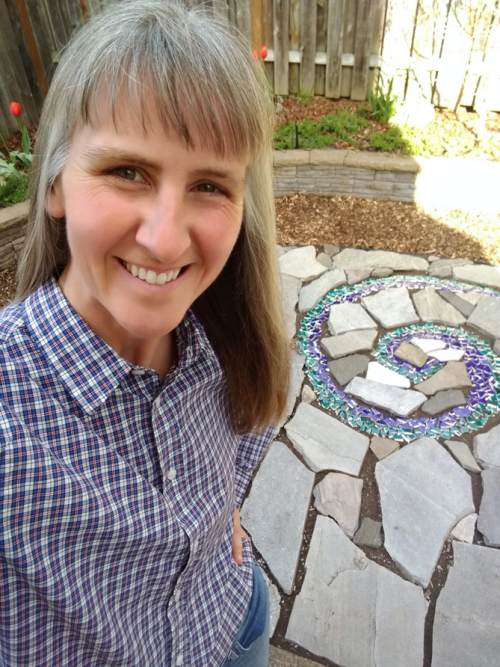This content was published: May 25, 2020. Phone numbers, email addresses, and other information may have changed.
Profiles From a Distance: Andrea Lowgren uses history to show how places evolve
Photos and story by Abe Proctor
Welcome to “Profiles From a Distance,” which is a series designed to showcase the talented and diverse cadre of people who constitute Portland Community College.
First up is Andrea Lowgren, an instructor of history at the Cascade Campus. A self-described “feminist social justice historian,” she’s also a world traveler, a hiking enthusiast, and an installer of artisanal backyard patios. Lowgren is also the creator and author of “The Reasons We Are Here: Oral Histories of Immigration at Portland Community College,” a collection of more than 20 oral histories from PCC students, faculty, and staff who have immigrated here from around the globe.
A permanent exhibit of “The Reasons We Are Here” is set to be installed on the first floor of Cascade Hall once the college reopens its physical facilities.
And, her History 251 course “African-American History Since 1877” examines the broad range of experiences of African Americans from reconstruction to the present. She developed the “Walk Albina’s Black History” as one of the most prominent aspects of the course, providing an opportunity for students and the public to walk along the history of the Albina neighborhood.
Why do you find history interesting and what motivated you to become a historian?
Andrea Lowgren: I find history compelling because it helps us understand the present. I’ve always been attracted to explanations. I want to know why things are the way they are and history offered the explanations that made sense to me.
What is your particular area of expertise, and what attracted you to it?
Lowgren: My area of expertise is 20th century history of the United States, with an emphasis on gender, sexuality and race. To be honest, I focused on U.S. history in college because the professor I liked best taught U.S. history, and I took every class he taught. As I matured in graduate school, I became most interested in the power dynamics that shape our interactions and that create inequality.
History can be unfairly maligned as a preoccupation with bygone eras, but a proper understanding of history can create context for current events, as well as a sense of resonance with past events. How do you seek to engender this understanding with your students?
Lowgren: The understanding of how history impacts the present is a thread in all of my teaching because I think it is what makes history a useful skill to the general public, not a specialty of academics. For example, while teaching U.S. history this term I am using first-hand accounts of immigration in which we study how the people’s lives have been shaped by U.S. foreign-policy decisions in the past. This ebook, “The Reasons We Are Here,” is an open educational resource, in case others would like to read these stories of PCC faculty, staff, students and alumni who so generously shared their stories to help my students connect the past with the present.
Through your courses and curricula, you’ve endeavored to create and maintain a connection with the history of inner North and Northeast Portland. How have you gone about this, and why is it important?
Lowgren: I find place-based history particularly engaging. One of my first profound experiences of history was taking a history class in Sevilla, Spain. On the first day of class we met in a cobblestone square in front of church and the professor told us that we were standing on the site of the Spanish Inquisition. That really made an impact on me and ever since then I have tried my best to know the history of the places that I visit and live.
With respect to the history of North/Northeast Portland, it is especially critical during aggressive gentrification that students know about the community of people that currently and formerly lived in this neighborhood. They need to know that these changes aren’t natural or random; we study the racist practices like redlining that created the Albina African American community and the federal urban renewal programs that undermined it. Ultimately the class creates a walking tour of the neighborhood to share this knowledge and analysis with others.
We’re all now living in a time unlike anything most of us have experienced. Is there a period of history that you feel best parallels our current situation?
Lowgren: That is a hard question to answer because I think that there are a lot of diverse experiences in different parts of our own society and all over the world. The shelter-in-place and social distancing orders that challenge middle-class Americans are in many ways a privilege, and aren’t possible for houseless people in Portland or folks in India where large families, small spaces, and lack of access to sanitation are common.
In general, how are you and your students adapting to education in the COVID-19 era?
Lowgren: Remote instruction has been challenging for both me and my students. While I understand its necessity right now, I think we all look forward to being able to return to the classroom.
How are you coping with the realities of social distancing? What TV shows should we be binging?
Lowgren: I’m not very adept at television, so I’m not sure. But I’ve got podcast recommendations: “Throughline,” “The Memory Palace” and “99% Invisible.” I’ve been coping by reading novels, taking a lot of walks and bike rides, and doing a lot of projects – weeding, organizing my garage and building a patio.

